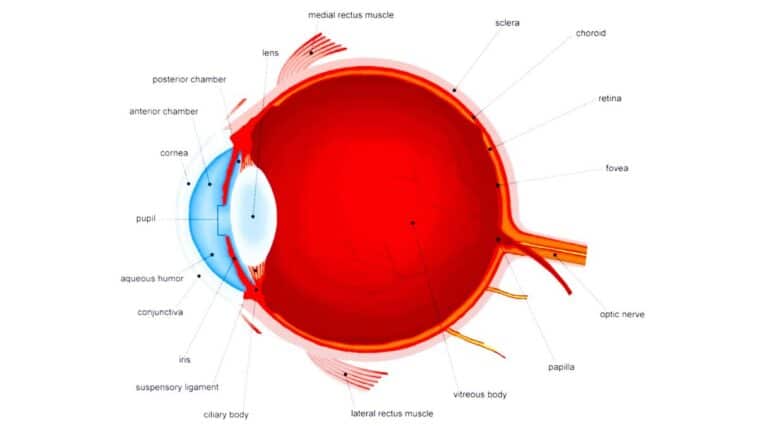Have you ever thought about how we see the world around us? How do humans see bright colors, detailed details, and magnificent landscapes? The optic nerve, a fascinating aspect of our vision system, holds the solution. This small but vital component transmits visual information from our eyes to our brain, allowing us to perceive and make sense of our surroundings.
In this post, we will delve deeper into the optic nerve’s secrets. We’ll look at its structure, functions, and the extraordinary journey it takes to offer us clear and correct vision. Whether you’re wondering about how your eyes operate or simply want to learn more about the human body, join us on an informative voyage into the world of visual perception.
Anatomy of the Optic Nerve
The optic nerve is more than just a bundle of fibers; it controls how we perceive the world visually. Think of it as a conduit for information, connecting your eyes to your brain and ensuring accurate transmission of every detail you perceive.
Origin is one of the key components. The optic nerve begins at the back of the eye, where it receives information from retinal ganglion cells. These cells function as the eyes’ reporters, collecting information from the light that enters your eye.
Optical disc: This is where the optic nerve exits the eye, sending critical information to the brain. Because your brain efficiently fills in the gaps, you don’t notice the “blind spot.”
Nerve Fiber Bundle: Consider these to be the optic nerve’s delivery system, neatly packaged and secured to ensure that visual information reaches the brain’s visual centers.
Optical Chiasm: Here is where the magic occurs. The optic nerve fibers cross pathways, processing information from both eyes on both sides of the brain to provide a comprehensive vision of the world.
Optical Tracts: These tracts function similarly to the final stretch of a relay race, transporting visual impulses to the brain’s visual processing centers for interpretation.
The Optic Nerve’s Function in Vision
The optic nerve does more than merely carry messages; it’s also responsible for converting those signals into the images we see every day.
1. Transmission of Visual Information: The optic nerve converts light signals acquired by your eyes into electrical impulses and transmits them to your brain. It’s like translating a foreign language into something your brain can comprehend.
2. Brain Integration: The brain processes and transforms these impulses into the vivid, colorful, and dynamic images you see all around you.
3. Creating Visual Perception: The brain uses these signals to detect objects, perceive depth, and comprehend motion. This is how you can appreciate a gorgeous sunset or respond to a ball thrown your way.
4. Spatial Orientation and Depth Perception: The optic nerve allows your brain to generate a 3D map of your surroundings, which aids in navigation and interaction with the world.
5. Peripheral Vision: Have you ever noticed something from the corner of your eye? Your optic nerve lets you know things even when you’re not looking.
6. Visual Memory and Recognition: The optic nerve helps you remember and recognize faces, locations, and objects, which enriches your experiences.
The optic nerve transmits visual information.
The path from light entering your eye to recognizing a friend’s face is nothing short of incredible.
Light detection and signal conversion: It all begins with light striking your retina’s photoreceptor cells. These cells turn light into electrical signals, similar to how a camera takes images.
The retina refines these signals before transmitting them to the brain, ensuring the highest level of accuracy possible.
The formation of optic nerve fibers: The axons of retinal ganglion cells connect to form the optic nerve, which transports these impulses from the eye to the brain.
Optical Chiasm and Pathways: The optic nerve fibers cross at the optic chiasm, allowing the brain to receive information from both eyes and generate a single image.
Transmission into the Brain: The optic tracts send impulses to the brain’s visual processing regions, where they are decoded into the images you see.
Common Disorders of the Optic Nerve
The optic nerve is extremely vital, but it is also susceptible to a variety of disorders that can impair vision.
Glaucoma: This condition causes increased pressure in the eye, which can damage the optic nerve and result in vision loss.
Optic Neuritis: The inflammation of the optic nerve, which is frequently associated with autoimmune illnesses, can cause sudden vision loss and pain.
Optic Disc Drusen: These calcium deposits in the optic nerve can cause visual issues.
Optic Nerve Tumors: Tumors close to the optic nerve can compress it, resulting in visual loss.
Ischemic Optic Neuropathy: This is when the optic nerve does not receive enough blood, resulting in damage and impaired vision.
Trauma: Injuries to the head or eye can cause optic nerve damage and impaired vision.
Diabetic Retinopathy: Diabetes can harm the blood vessels that supply the optic nerve, resulting in vision problems.
How to Diagnose Optic Nerve Disorders
Getting to the bottom of optic nerve problems necessitates a thorough examination and specific tests.
Comprehensive Eye Examination: A thorough examination looks at everything from your vision to the condition of your optic nerve.
Visual Field Testing: This exam assesses your peripheral vision to determine whether there is any damage.
Ophthalmoscopy: This method provides a close-up picture of the optic nerve, which aids in detecting any issues.
Optical Coherence Tomography (OCT): This imaging test examines your retina and optic nerve in cross-section.
• Visual Evoked Potentials (VEP): This test gauges the speed at which visual information travels from your eyes to your brain.
MRI scans offer comprehensive images of the brain and optic nerve, which are critical for detecting malignancies or inflammation.
Treatments for Optic Nerve Conditions
The underlying cause determines the treatment for optic nerve problems.
Glaucoma: Medicine, laser therapy, or surgery can all assist to lower eye pressure and protect the optic nerve.
Optic Neuritis: Corticosteroids and immune-modulating medications can help reduce inflammation and speed up healing.
Optic Nerve Tumors: Treatment for optic nerve tumors may include surgery, radiation therapy, or chemotherapy.
Ischemic Optic Neuropathy: Treating underlying problems and increasing blood flow can help protect the optic nerve.
Compressive Optic Neuropathy: Surgery or medicines may be required to alleviate strain on the optic nerve.
The importance of regular eye exams
Regular eye exams are essential for maintaining your optic nerve—and your vision—in peak form.
Early Detection: Many optic nerve issues do not cause symptoms until considerable damage has occurred. Regular exams identify problems early.
Monitoring Changes: Eye exams help track changes in your optic nerve health over time, allowing for prompt therapy.
Preventive Care: Exams can identify risk factors early on, allowing you to take precautions to preserve your optic nerve.
Personalized Treatment: Early diagnosis results in more effective treatment approaches.
Conclusion:
The optic nerve is a miracle of the human body, playing an important part in how we see and interpret our surroundings. Understanding its function and importance allows us to better appreciate the need for frequent eye exams and preventive treatment. With the proper care and treatment, you can continue to experience all of life’s beauty and wonder via your vision.






